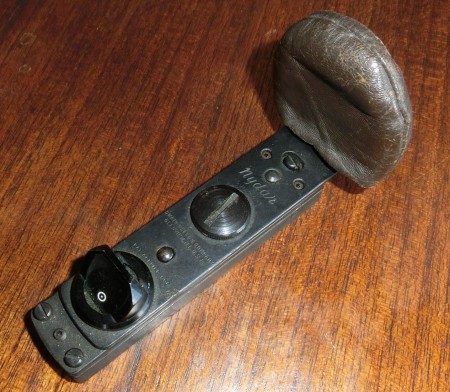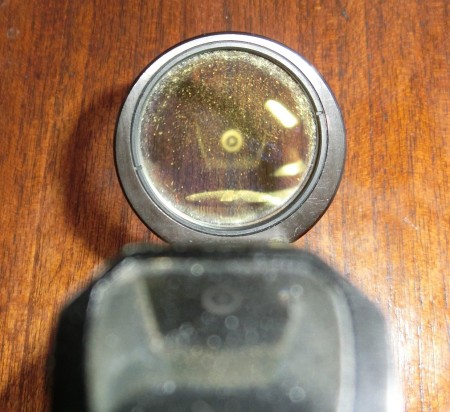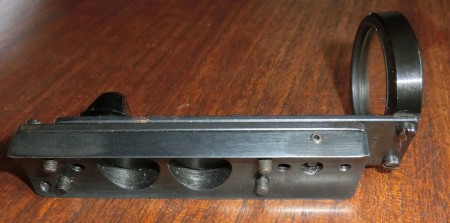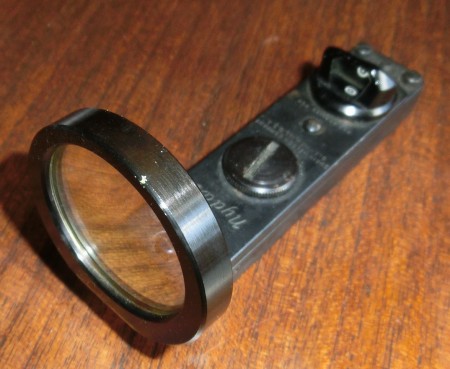The basic technology for the Army’s fancy high-tech M68 CCO (the Aimpoint) was first patented all the way back in 1900. The concept of the reflex sight, in brief, is that ambient light is used to reflect a reticle pattern through a lens into a shooter’s line of sight. When properly mounted on a gun, that reticle can be used for aiming. The first reflex-type gunsights were mounted in fighter aircraft in late World War I, and by World War II they were standard equipment. Up to that point, though, they were fairly bulky and fragile, though, and so the market for reflex sights on small arms didn’t really show up until the end of WWII.
One of the first commercially fairly successful such sights was the Nydar Model 47, made by the Swain Nelson company and introduced in 1945. It was intended as a sight for shotgun hunters, to aid in firing on flying birds (basically the same application as when used in fighter aircraft). We had the chance to take a look at one recently, and it’s pretty neat:

The main lens is fairly large by today’s standards, close to 1.5 inches. The reticle is a white bullseye pattern, and is a bit dim but definitely visible (I would rate it as more visible than the integrated sight on the FN PS90).

The reticle looks better in person; it was a bit tricky to get a photograph of it. As with today’s optical sights, multiple different mounting bases were made so that the standard sight unit could be attached to a variety of different shotguns.

We haven’t tried actually using one of these, but the general consensus is that they were a bit fragile. They never really became popular, and it was really only with the fairly recent military acceptance of close-range optical sights that popular interest in them has really become widespread.


Patent application filed at Sept,28, 1945 for Mr. Clinton S.Davis and published
eight years later at March 31. 1953 with Serial Number, 2 633 051.
https://docs.google.com/a/student.thomasmore.be/viewer?url=patentimages.storage.googleapis.com/pdfs/US2633051.pdf
It is true everything old is new again.
And the principle of “Pepper’s Ghost” was known at least as far back as 1584, according to Wikipedia.
I used to own one of these. It was next to useless without extremely bright ambient light. Fine if you live in the desert, and only plan to shoot in the middle of the day. There is a reason why modern reflex sights use an artificial light source instead of simple contrast.
On an interesting side note, the military purchased a number of shotguns set up with Nydar sights as training aids for aircraft gunners.
Took a tour of a B17 at an air show several years ago, and the 50 caliber guns had some sort of reflex sight as well. Knew that they were used by fighter pilots, but had no idea that they were used by gunners. It would be interesting to know if there was any way to set the lead on them and if so if that made them more effective. Of course that was all made obsolete by the B29’s analog computers and remote controlled turrets.
You are correct, the reflex sights of that period could be adjusted for lead and target size, and this applied to both flexible as well as turret-mounted guns in bombers such as the B-17 and B-24, not to mention the fixed-gun applications in fighter aircraft. If you are interested, there are numerous publications on the technical aspects of electronic lead-computing gunsights that saw general service, such as the Sperry K-3 top turret ( dorsal turret, for you RAF types ), Sperry K-4 ball turret gun sight, and the K-13 gun sight used on flexible .50-caliber mounts. These, along with numerous similar applications to the USAAC and USAAF of the Second World War, should provide you with a good starting point — and I mean, STARTING POINT. There are many, many more such examples, too numerous to be mentioned in detail here, that were in service with RAF Fighter and Bomber Commands ( eg., in the Frazer-Nash and Boulton-Paul turrets ), the Luftwaffe, the Soviet Union, Italy and other air arms.
Frankly, this arena constitutes an entirely separate, unique and highly-comprehensive area of technical, mechanical and historical knowledge in its own right ; how much you want to learn, and how much you choose to contribute, is only limited by how far you want to go with the subject. Case in point : After 40 years or so of delving into this, I am still learning something new every time I look into it.
Definitely a clever device given state of technology of time. Actually, the current sights may vary only in using artificial illumination. If it was enclosed in sort of housing, it would be less vulnerable to damage, this being the weak point perhaps.
I am glad to see some interest in sighting devices; they complement firearms for many decades. Let’s continue the trend.
Excellent point, Denny.
I saw a reprinted add for the Nydar in an American Rifleman years ago. I don’t recall the exact price but I remember noting that it was a lot of money for the time. I guess it still holds true today when you look at what high end glass costs.
My dad also has an old Nydar. A neat concept indeed but not all the bright and really not a substitute for learning how to wing shoot.
I was lucky enough to come across one of these years ago, (when the first huge Tasco dot sight was still a thing) and jury-rigged it to a 10/22 just for kicks. Within a certain range, you could keep a can rolling with that thing like nobody’s business. Being a basically NIB specimen, I wound up selling it to a collector for the princely 1980’s sum of $50. I wish I’d just hung onto it now.
EXCUSE ME…It was not a Tasco dot sight…but the huge and funny looking Weaver Quick point sight that
was still a thing.
The mind goes first, folks.
From what I’ve read of your other posts and comments — most of which were very perceptive — I don’t think your mind is going any faster than for the rest of us :). Probably better than mine, anyway!
I wonder how those sights were adjusted when they were being set assembled.
The steel ring which holds the lens is eccentric,
that raises the possibility of getting the flat on its base in the wrong place, and putting the centre of the lens eccentric to where it should be.
yet there doesn’t appear to be any way of correcting for that.
Hmmm… I have two of these. They work pretty well in Colorado. The dot is pretty big for a bullet gun, but on a shogun it is rather nifty. I have thought about “pumping” the nydar with an led, but I’ve only thought about it thus far.
I also have a pair of the aforementioned Qwick Points they are in every way better than the nydar, but nowhere near as cool.
Cyrus, thanks for sharing your unique experiences and ownership! I hope you decide to keep the Nydars and Weaver Qwick Points exactly as is, because they will be priceless as is sooner or later, at least from a historical standpoint.
Although the lens might be fragile, the Nydar was machined from tool steel & seems very robust!
Back befor the first dot sights came out(in europe)Parker Hale came out with a reflex sight(no batteries)in 1980/81? for airrifles in the uk. It was typical parkrhale quality and I tried to put it on a sten mk111 back in canada but we coundn’t ajust it On a single shot 22 it wasn’t bad. I’ve still got it but the sighting point has faded to next to nothing
I’m no expert on the Parker-Hale reflex sight, but I’m guessing it might be worth something at some point from a historical and collector’s standpoint if kept in it’s original configuration. Any ideas?
I have a Nydar sight mounted on a Winchester Model 12. The shotgun and sight belonged to my dad many years ago. He would shoot 100 straight at the Salt Lake Gun club. This was in the 1950’s. Anyone have an idea what it might be worth today?
I hsve one of these…model 47. Says patent applied for. Pre wwII?
When my father passed away in 03 I found this sight on his 16ga side by side. I remember when I was a kid being able to hold the gun and look down the site. Never fired the gun though. He even kept the box and leather cover. Anyone know how to clean the main lense?
Dad put one on his 16 gauge Remington M11 in 1947 or 1948 when we moved back to Oklahoma. He didn’t like very well and traded it off. It took longer to get on quail than other guys he shot with and he was already at a disadvantage as his automatic was loading the 5th round when his hunting buddy’s 1897 Winchester was empty. The 1897 didn’t have a disconnecter and would fire every thine the bolt when into battery if the trigger was held down.
I carried a side by side double and seldom got a second shot. They took me alone so they could kill another limit.
I have 3 of these Nydar 47’s i’ve picked up over the years. Two are in the boxes with all the paperwork. One box still has a price sticker of $27.95 on it. Have never tried to use one or even mount one. When looking thru them inside my shop they look fine, but, go outside in sunlight, or pointed toward the sky, they are useless, the aimpoint disappears unless pointed at trees or some darker background. Not sure how you would shoot high flyers! As far as adjusting the sight, the adjustments are all made in the base with the various screws.
Probably Hi tech back in the 40’s.
Hi. Inherited a Remington 12 gauge from my father – was his fathers duck hunting gun I remember this gun and used it as a kid. It has the mount for the Nydar 47 but it did not come to me with the acutal sight. If you would be interested in selling one of the three you have, please let me know. Thank you. Lee
Just bought one on eBay for $100 +/- $5. Just so cool looking I had to have one. Been collecting old sights,Lyman, Marble and such. There’s another one for sale starting at $395!!! So there worth is debatable. By the way you all have a very mature and pleasant group of people here. A nice change from some sights with name calling and petty bickering.
Found two of these (Nydars) at a gun store in Boulder, CO (Gunsport) a couple of years ago. Bought one for $25 — apparently, less than it cost new, even though they were NIB with manuals and everything.
Drilled and tapped a Weaver rail so I could mount it on a Mossberg 20 gauge pump. The sight picture is fine during the day anywhere I pointed it, but can’t see it at night. The large size of the central dot isn’t a problem, as you can see the target through it — it is easy to center on even a small bullseye.
Took it to a pistol range (25yd) and shot about 50 slugs (all they would let me shoot there — no shot allowed).
After it was sighted in, I could put as many slugs as you like through a 3/4 in hole at 25 yards. (Eventually, the target gets chewed up by the plastic wads, which have about a 12 in spread at that range.)
That’s a lot better than I can do with the bead sight, and just as good as I do with a standard red dot.
Well I happened on this thread by accident while looking for info about Nydar 47 sights. Maybe an old thread, but for the sake of my shooter friends…I just saw these for sale at Numeric/Gun parts inc under “misc sights”. It didn’t say out of stock so I assume they were still available. $75 used with a lens cover. Good luck!
Product # 1631150
i have a naydar site on my model 29 remington
Going through hand me downs I came across a Nydar site. It’s in a box labeled for 16 gauge Ithaca. I have the Ithaca model 37 which I’d like to keep. I would be willing to part with the Nydar site. It does have some snowflake like clouding in the lens which won’t wipe off from the outside. I think all the parts are there.
I, received my first Naydar sight from my father, mounted on a 12ga single shot long Tom.This has sparked my interest , and I have six now . I love these old sights for what they are. I have picked a few up and even learned how to replace the mirrored film on the inside lens.Once cleaned and new film applied they have a really good image .I mounted one on a picatinny mount, and mounted it on a Keltec bull pup shotgun and it preform’s really well, after bore sighting . They made two style mount’s one for side by side and one for a pump or automatic .
Does anyone have the drill guide for the model 12 version of this sight? Id like to get mine mounted on my ’45 model 12. but without the drill guides it may be too risky
I remember this Naydar sight written up in an issue of the NRA American Rifleman back in the 1980’s. From what I remember, they did become popular, especially with the skeet shooters. The article stated that the sight was so good that if someone showed up with one on there shotgun for a skeet competition, they were given a handicap. What they did was to adapt WWII reflex sighting for large guns that they made for aircraft and navel guns like the anti-aircraft 20mm Oerlikon. When mounted properly. the ring and dot was where the round was going, no matter where it was showing on the glass.
From what I understood, this sight was not fragile. They just adapted the design by making it smaller. Now by saying that it wasn’t fragile, doesn’t mean that it could take a beating or a 12 foot drop to a cement floor, but it was a bit stronger than the scopes of that time. Remember, the original sights were made for some big weapons, like the 20mm navel guns to shoot down aircraft. They were made to survive the firing and recoil of those weapons.
Also in that article they stated that the mount was also what adjusted the sights aiming point. It was made for both shotguns and rifles. So you could have one Naydar Sight and several guns with the mount on them. It said that you could take the sight off of your shotgun and put it on the rifle and it was already sighted in to shoot.
This sight was also suppose to be good in low light conditions, but not good in the dark. Much better in low light than iron sights of that time, like in a heavy forested area, but about the same as iron sights at night, useless.
I guess people today can look back and laugh or think of it as being silly or stupid with what we have today. But remember, in the late 1940’s through the 1970’s we didn’t have much in electronics that were small enough to fit on a gun that wasn’t bulky. Those devices also needed a lot more power than what is out there today and the batteries they had back then didn’t last long. By the end of WWII the US had a night vision scope that was used in combat. But it had a back back similar to the radio pack, except it was full of a battery just to power that scope. By Vietnam we had the Starlight, better but not much smaller. Today we have night vision that we wear on our heads that take a couple of coin batteries and small electronic sights, small enough to mount on pistols.
So the Naydar sight had it’s place and was good for it’s time. It got replaced by the first Read Dot sights in the 1960’s that were better.
Great post however , I was wanting to know if you could write a litte more on this subject? I’d be very thankful if you could elaborate a little bit more. Many thanks!
Hi, Neat post. There’s a problem with your web site in internet explorer, would check this?IE still is the market leader and a good portion of people will miss your excellent writing because of this problem.
I have one of these in new condition in the box. Pretty neat!
I found one of these at my local shop. We are now looking for how best to rig it onto a dealer sample STEN MKII S reproduction that has no front iron.
Just for a fun what if idea.